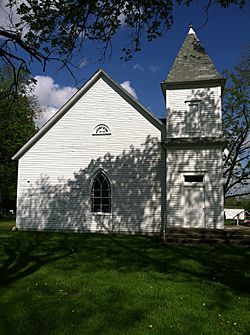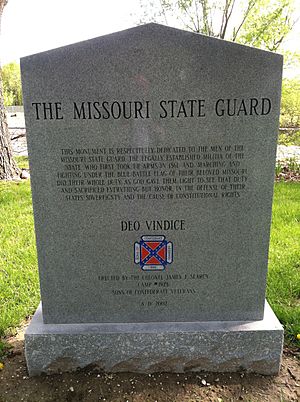Battle of Mount Zion Church facts for kids
Quick facts for kids Battle of Mount Zion Churches |
|||||||
|---|---|---|---|---|---|---|---|
| Part of the Trans-Mississippi Theater of the American Civil War |
|||||||
 Mt. Zion Church from the west |
|||||||
|
|||||||
| Belligerents | |||||||
| Commanders and leaders | |||||||
| Units involved | |||||||
| 3rd Missouri Cavalry Birge's Western Sharpshooters |
Missouri State Guard | ||||||
| Strength | |||||||
| 440 | ~900 | ||||||
| Casualties and losses | |||||||
| 3 dead 63 wounded 4 captured |
~25 dead ~150 wounded 60 captured |
||||||
The Battle of Mount Zion Church was a fight during the American Civil War. It happened on December 28, 1861, in Boone County, Missouri, near the Mount Zion Church. The Union side won this battle.
This victory was important because it stopped the Confederate side from getting new soldiers in central Missouri. It also pushed Confederate forces out of the area. They did not return in large numbers until 1864, when General Sterling Price led an invasion called Price's Missouri Expedition.
Contents
Union Forces Move In
Brigadier General Benjamin Prentiss led a group of Union soldiers into Boone County. His force included five companies of the Third Missouri Cavalry and two companies of Birge's Western Sharpshooters. Their main goals were to protect the North Missouri Railroad and stop the Missouri State Guard from organizing. They also wanted to show Union strength in the area.
General Prentiss and his troops left their base in Palmyra, Missouri, on December 24. They arrived in Sturgeon on December 26.
First Skirmish Near Hallsville
In Sturgeon, Prentiss learned that the State Guard was gathering near Hallsville. On December 27, he sent a company of soldiers to Hallsville. This Union group fought a small battle with a State Guard unit led by Colonel Caleb Dorsey.
This short fight lasted about 10 minutes. It took place about half a mile north of Mount Zion Church. The church itself was about 3 miles southeast of Hallsville. Prentiss's troops had some soldiers injured and some were captured. They then went back to Sturgeon by 6 p.m.
The Battle at Mount Zion
On December 28, around 2 a.m., General Prentiss moved his entire force to find Dorsey's troops. The State Guardsmen had about 900 soldiers. However, many of them were local volunteers. Most did not have military weapons, though some had their own guns.
A small group of Prentiss's soldiers found and defeated one company of Guardsmen. This happened on the road from Hallsville, about 100 yards east of Mount Zion Church. The Union soldiers learned that the rest of the State Guard was in the churchyard. This area was on a high hill. The main camp was in a thick, wooded hollow just east of the church.
Prentiss's troops attacked the State Guard positions three times. During the third attack, the Confederate soldiers ran out of bullets. They fell back to their wagons and were then defeated. The battle ended around 11 a.m.
What Happened Next
The Missouri State Guard was forced out of northern Boone County and retreated towards Columbia. Dorsey's forces lost about 25 soldiers who died, 150 who were wounded, and 60 who were captured. They also lost wagons, 90 horses, and 105 weapons.
The remaining Confederate soldiers scattered. Dorsey headed west toward the Missouri River. After talking and exchanging prisoners, Dorsey set up camp near Everett, Missouri. A few days later, Dorsey received orders from State Guard commander Major General Sterling Price to break up his forces.
The Battle of Mount Zion and another battle called battle of Roan's Tan Yard stopped the State Guard from forming large groups in Central Missouri. Some of Dorsey's remaining soldiers crossed the Missouri River and joined General Pierce in February 1862. While some guerrilla warfare (small, unofficial fights) continued, the Confederates did not fight large battles in this area again until Price's Raid in the autumn of 1864.
Mount Zion Today
Today, the Mount Zion Church and its cemetery are important historical sites. They are listed on the National Register of Historic Places. The cemetery has the graves of soldiers who died in the battle. There is also a memorial marker for the Missouri State Guard.
Images for kids






